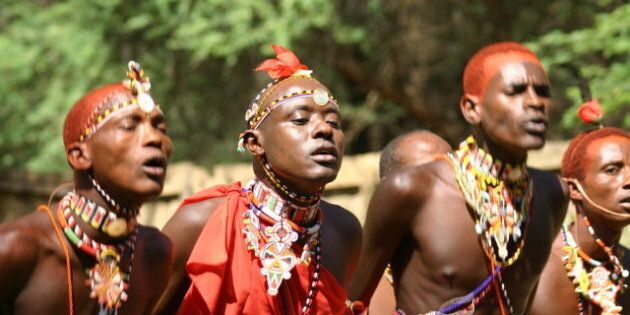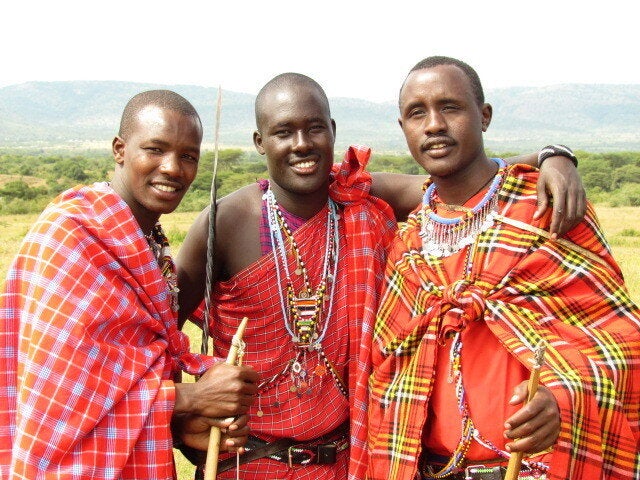
Friends Wilson Meikuaya and Jackson Ntirkana are both from the Maasai nation in Eastern Africa. The Maasai are traditionally a semi-nomadic people from Kenya and northern Tanzania known as fierce warriors and cattle-thieves.
In this excerpt from their autobiography, "The Last Maasai Warriors," Meikuaya, a partner of Me to We, talks about his struggles with trying to blend the honourable but aging traditions of the tribe with Western philosophies to encourage young people to persevere and adapt to their changing environment.
We Maasai never defy our parents’ wishes. I had already pushed the boundaries for years with my father, who never wanted me to go to school but had allowed it, begrudgingly. I know he wasn’t happy for me to be away from our boma spending my days in classrooms with children from other Kenyan tribes, many of whom led more Western lifestyles in their homes.
When I received the message that I was needed to help take the herds to Tanzania, I sadly closed my reading books and gave my math assignments to my uncle Rotiken for safekeeping. “I will come back to school,” I told him, “when the rains return.”
I smiled when I said these words, but I was choking back tears. For me, school was my passion; and every year since starting school, at about seven years old, I wondered: “Will this be my last?”
“This year, maybe it just might be,” I thought as I dragged my feet along the dirt path toward my family’s boma.
Out in the middle of the Maasai Mara, at the southern edge of Kenya, Tanzania isn’t marked by a line or a border with guards checking our passports and giving us permission to enter. For the Maasai, crossing from one country to another comes with just a feeling that we are no longer on the Kenyan side of Maasailand.
But before crossing into Tanzania, my father told me, we were going to stop at the boma of the great prophet, Oloruma, one of the wisest men in all of the Maasai Mara. Our elders trusted him to guide them on how to best lead their lives and what the future would bring.
“I want to know,” my father explained, his face lined with wrinkles from the heat and the dusty, dry air, “How long this drought will continue and if there is anything we can do to stop it.”
“Like kill a particular sheep for Enkai?” I asked.
My father nodded. I smiled.
A part of my mind wanted to believe that the Maasai ritual of slaughtering a sheep for Enkai, our God, as a sacrifice, to get her to bring rain, actually worked. But I had been at school for many years. There, I studied science and geography. I knew that global warming was the real cause of our droughts, and no matter how much we prayed and honoured Enkai, only environmental change would really help bring back our rains.
I put my arm around my father’s shoulder. “Papai, I am sure the oloiboni will know what to do,” I whispered in a consoling voice, for my father had never set foot in a schoolhouse and knew nothing about environmental change. “I am sure the oloiboni will help us.”
When we arrived at the boma, my mother and sisters were invited to prepare our evening meal and sleep in one of the manyattas—the buildings in the boma—belonging to the wives. My father, older brothers and I, however, would sleep outside with the cows.
We made our way to a clearing close to the manyatta and created a makeshift boma by constructing a thick, round fence out of white bush, orange croton and acacia branches. The cows would spend the night inside the enclosure, the thorns on the bushes separating them from their predators—the lions that roamed the open fields at night.
When we were done, the moon was low in the sky—bright, round and full. The children of the manyatta, along with my younger brothers and sisters, began singing.
I followed my father to Oloruma’s manyatta. It was the first time I was allowed to see the prophet, let alone take part in one of the ceremonies in which he predicted the future.
I was nervous as I entered the dark, smoky hut. Only the dying coals of a fire set deep in a cement hole in the ground lit the main room. One of my brothers had told me that if the oloiboni did not like me, or if he felt I was bad or had a bad future, he would single me out.
“If he really doesn’t like you,” my brother had said, “he will tell you to leave. Having to single you out in a prediction is the worst thing that can happen to a Maasai…even worse than losing a cow.”
Although there are many prophets among the Maasai’s seventeen different language groups, the one who represents my dialect, purko, is the great-great-great-grandson of Agoolonana, who made a crucial prediction generations earlier, one that the Maasai everywhere followed. To this day, many credit Agoolonana with the very survival of the Maasai.'
You see, there are forty-two tribes in Kenya. But we, the Maasai tribe, have always stayed pretty much on our own out in the Maasai Mara. We would raid cows from the Kipsigis, our nearest neighbours, but that was pretty much our only contact with non-Maasai. And our Maasai prophets usually predicted whether these raids would be successful or not, for almost always someone would be killed in the conflict.
One time, however, when our ancestors visited Agoolonana, he didn’t talk about the upcoming raid. Instead, he drew some squiggly lines on the ground and said a long snake was going to come between the Maasai and the other tribes.
“Can we hit the snake on the head and kill it?” a young warrior had asked.
“No,” the prophet replied, “for this snake is not a real snake. It is a big black snake and it is bringing something white with it. It is bringing both good and bad. I don’t know what type of snake this is. So be careful. Be very careful.”
“What can we do?” asked another Maasai warrior.
The prophet stood up, waved his arms and drew a line right through the snake he had drawn on the ground. “This represents our Maasai lands on one side, and the rest of the lands on the other,” he said. “This line is a border,” he continued. “The snake cannot pass this border. If it does, the Maasai will be invisible to it.”
What came to pass is that the snake represented a highway, and that highway brought with it the British colonialists, who connected the tribes of Kenya through education, commerce and politics. We Maasai didn’t assimilate, however. The line Agoolonana drew in the sand came to represent a real line that now runs for hundreds of kilometres through the forests and over the mountains of the Great Rift Valley. The line is so long it is said that Enkai, in the heavens above, can see it. And that line is where Kenya ends and the Maasai Mara begins.
I felt privileged to finally be in the presence of the oloiboni, but also very frightened—I didn’t want to leave home for good because he didn’t like me!
In the manyatta, I sat on the bed made out of lantana camera and white bush leaves, squished in beside my two older brothers, both initiated warriors, while the oloiboni began the ceremony. He first blessed the local brew my mother and my father’s other wives had made, and poured it into plastic teacups, which he passed to the elders in the room, including my father.
After taking a long drink, Oloruma broke into song.
“We were so successful on the hunt, we came home with two lions.”
“Aaraposhoki osinkolio loo ngishu,” the others in the room sang, when the oloiboni paused.
“I marched into the boma with the lion’s mane and tail, to be greeted by my generation, so pleased, so pleased,” the oloiboni continued.
“Aaraposhoki osinkolio loo ngishu,” the others repeated. Everyone, except me, seemed to know what to sing. They’d all been here before.
When the big yellow plastic container of brew was finished, Oloruma was given another. Not once, however, did we stop singing. Sometimes the oloiboni would sing the chorus. Other times, he initiated the songs.
When his eyes were finally red from drink, and his movements slow, as if he was in a trance, he took white chalk from a small leather bag he wore around his neck and drew wide circles around his eyes. He then drew lines on his hair and on the foreheads of the senior elders in the room.
“And for the prettiest girl,” he sang while doing this, “I leapt for her and made her smile.”
“Kitederrie oloiboni nelo entara Meeishaki enaibon enkop nikiyieu,” everyone sang.
Then abruptly, the singing stopped. The oloiboni had put his hand in the air. The room fell eerily silent. The only sounds were the crackling of embers in the fire and the crickets rubbing their legs together in the long savannah grasses.
Oloruma started singing again, but this time, it was not a song. It was a prophecy:
“The drought will end after one complete cycle of all the full moons. The cows will return to their lands and you will have food.”
“And you,” he then said, pointing his walking stick at me.
My back straightened. I stopped breathing as his dark brown eyes peered into mine.
“And you,” he said again, as I reached to touch his walking stick, like the others had done when he had pointed the stick at them. My hand shook as I did so.
“And you,” he repeated, as my fingers felt the smooth wood. When he had pointed the stick at the other Maasai, he had done so merely as a way to bless them. He hadn’t said anything to them.
“And you,” he said a fourth time, as I held my shaking knees. “You will one day work with the white people. You will bring our story to non-Maasai people. You will be our bridge. The bridge of your generation to the world.”
I exhaled, letting go of all my fears that the oloiboni would say I was a bad person, and then inhaled all my excitement and held my breath. We Maasai are taught as young children to never show emotion, so I needed to hide how I felt.
As the oloiboni returned to singing, my mind turned to my life, as someone who was now part Maasai and part Western schoolboy. I thought of my teachers and my lessons, both on the Mara and in the classroom, and how the two differed yet also merged. Then I thought of Jackson, my closest friend. There was no way I was going to do what the oloiboni predicted without him.
Have you ever been to 'that place,' where you feel your destiny was confirmed by someone else and how did that affect your life? Let us know in the comments below.
Read more about the authors' transformed lives in this 2012 interview.
SEE: Meikuaya and Ntirkana lead an AOL Canada's group through Kenya's Maasai Mara district in June 2012.
